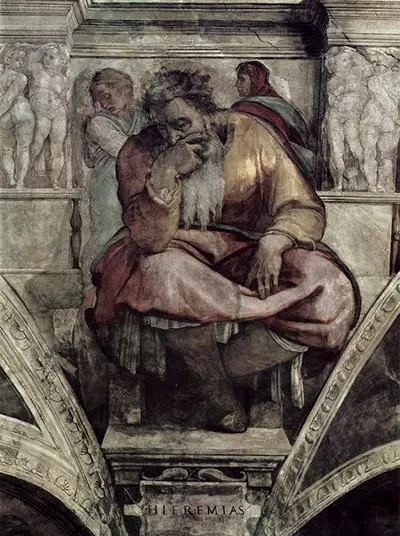Michelangelo painted in total, seven of the holy prophets, all of whom are located in the Sistine Chapel. Jeremiah is located to the far left of the ceiling, close to the High Altar.
Michelangelo painted Jeremiah the Prophet in a state of quiet contemplation. He has been painted to evoke the feelings of loss and of anguish following the destruction of Jerusalem. The image of Jeremiah has been captured at the time of the great downfall of his beloved holy city, and many art critics have suggested that Michelangelo drew on his own sins to capture the raw emotion that is clearly evoked within Jeremiah.
Jeremiah is an incredibly moving portrait, that shows the prophet lived through great sorrow until his final death. As an observer, we too feel great sorrow, as we clearly observe his hand grasping his beard in a thoughtful gesture. We also cannot see his mouth and his hand is raised in the gesture of signum harpocraticum that displays to the observer that he has great and all knowing powers.
As well as Michelangelo drawing upon his own sense of guilt and past indiscretions, for the inspiration behind the painting of Jeremiah, many also believe that the painting of the prophet is somewhat the representation of an early alter ego, based on what Michelangelo thought he would look like and feel, as an older man. The Renaissance artists believed that age truly created wisdom.
What we observe is an old man sitting hunched over on his throne, his legs crossed, head bowed and face obscured. All of the colours are natural and muted, apart from the vivid robes that Jeremiah wears and his trailing white beard. In one hand he holds his beard, his chin slightly jutting out towards us, as well as the finely sculpted and prominent nose that appears between finger and thumb.
Placed next to him on the throne is a scroll, with Alef printed upon it.
Michelangelo pained this to represent the Book of Lamentations and beside him we observe various women in a state of mourning for their beloved Jerusalem. Although Jeremiah has been painted as an old man, we can clearly see his strength, his beauty and his wisdom despite his suffering.


